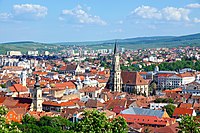
Photo from wikipedia
Scholars have shown a special interest in discovering and studying the role of ethnic diversity and spatiality at the country and region levels. This study contributes to the theoretical debate… Click to show full abstract
Scholars have shown a special interest in discovering and studying the role of ethnic diversity and spatiality at the country and region levels. This study contributes to the theoretical debate on the spatial dynamics of ethnicities, with the aim of (1) determining the evolution of ethnic dynamics in post-communist Romania and (2) applying ethnic fractionalisation and polarisation indices. The study uses a mixed methods approach based on a descriptive statistics analysis and applies the fractionalisation and polarisation indices to Romania’s NUTS-3 (i.e., county) level. The findings suggest that the ethnic spatial dynamics in post-communist Romania have shown a decrease in all ethnicities due to migration and low birth rates, with the exception of the Roma ethnicity, for whom the trend is increasing. Additionally, polarisation and fractionalisation indices have different evolutionary manifestations depending on the dynamics of the ethnic groups present in certain geographical areas. Although neither of the two analysed indices has witnessed profound change at the spatial level, these small changes in spatial and short-term ethnic diversity can help us advance knowledge about co-existence in ethnically diverse societies. Higher values of the two indices are obvious in several counties where ethnic Hungarians cohabitate with Romanians and other ethnicities. This discovery can inform policy-makers to implement more policies for the further peaceful co-existence of Hungarians, Romanians, and other ethnic groups in Transylvania and other western counties in Romania. Furthermore, as the population growth trend for the Roma ethnicity is upward, Romania has to implement proper policies and build better government infrastructure to counter social inequality against the Roma people. This will help curb potential conflicts between the Roma and other ethnic groups at the local level. Finally, as most ethnicities decreased in number in post-communist times, further attention needs to be paid to the erosion of ethnic diversity in Romania because this could have a negative impact on economic development, social trust, and democracy.
Journal Title: Land
Year Published: 2023
Link to full text (if available)
Share on Social Media: Sign Up to like & get
recommendations!